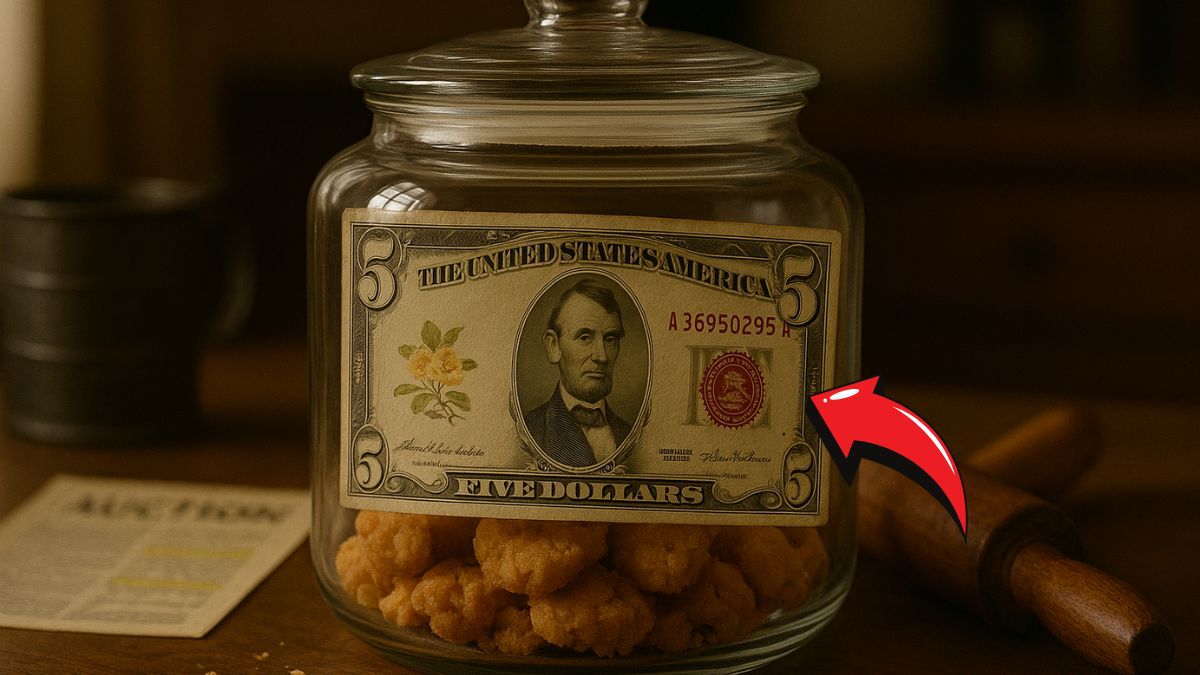This $5 Red Seal Bill Found in a Cookie Jar Just Shattered Auction Records
In a remarkable turn of events, a rare $5 red seal bill was discovered inside an old cookie jar during a family estate sale in Ohio.
This unexpected find has captivated collectors and numismatists alike, culminating in a record-breaking auction that underscores the enduring value of historical currency.
Understanding Red Seal Notes
Red seal notes, officially known as United States Notes, were issued directly by the U.S. Treasury and are distinguishable by their red treasury seal and serial numbers.
Unlike Federal Reserve Notes, red seal notes were part of a limited issuance, making them particularly valuable to collectors.
Key Features of Red Seal Notes:
- Red Treasury Seal: Located on the right side of the note.
- Red Serial Numbers: Matching the color of the treasury seal.
- Portrait: Features Abraham Lincoln on the obverse.
- Issuance Period: Primarily between 1928 and 1963.
The Discovery: A Collector’s Dream
The bill in question is a 1963 Series $5 red seal note, found in near-mint condition.
Its preservation is attributed to its storage in a cookie jar, shielding it from environmental factors that typically degrade paper currency.
The note’s serial number, A40869368A, and its pristine state significantly contributed to its desirability among collectors.
The Auction: Bidding War and Record Sale
Upon authentication, the note was listed on a reputable auction platform specializing in rare currency.
The auction garnered significant attention, resulting in a competitive bidding war.
Auction Details:
- Starting Bid: $10
- Final Sale Price: $3,750
- Number of Bidders: 15
- Auction Duration: 7 days
This sale set a new record for a 1963 Series $5 red seal note, highlighting the note’s exceptional condition and the growing interest in collectible currency.
Factors Influencing the Note’s Value
Several elements contributed to the note’s impressive auction performance:
- Rarity: Limited production run of the 1963 series red seal notes.
- Condition: Near-uncirculated state enhanced its desirability.
- Historical Significance: As one of the last red seal notes issued, it holds particular historical value.
- Collector Demand: Increasing interest in mid-20th-century U.S. currency.
Comparative Analysis: Red Seal Note Auction Results
To contextualize this sale, consider recent auction results for red seal notes:
| Series Year | Condition | Auction Price | Remarks |
|---|---|---|---|
| 1928 | Very Fine | $1,200 | Early series, moderate rarity |
| 1934A (Hawaii) | Fine | $2,500 | WWII emergency issue |
| 1953 | Near Uncirculated | $1,800 | Increasing collector interest |
| 1963 | Near Uncirculated | $3,750 | Recent record-breaking sale |
The Collector’s Market: A Growing Interest
The fervor surrounding this red seal note is indicative of a broader trend in the numismatic community.
Collectors are increasingly seeking out unique and rare currency pieces, driving up demand and prices.
Red seal notes, with their distinct markings and limited runs, are at the forefront of this surge in interest.
This remarkable discovery serves as a reminder that valuable treasures can often be found in the most unexpected places.
For collectors and enthusiasts, it emphasizes the importance of vigilance and knowledge in identifying rare items.
As the market for collectible currency continues to grow, who knows what other hidden gems await discovery?
FAQs
How can I identify a red seal note?
Red seal notes are distinguishable by their red treasury seal and red serial numbers. They were issued directly by the U.S. Treasury and typically feature a portrait of Abraham Lincoln on the obverse.
Are all red seal notes valuable?
Not necessarily. The value of a red seal note depends on factors such as its series year, condition, rarity, and demand among collectors. Notes in pristine condition or from limited production runs are generally more valuable.
Where can I sell or auction a red seal note?
You can approach reputable auction houses specializing in currency, such as Heritage Auctions or Stack’s Bowers. Online platforms like eBay also host auctions for collectible currency.

